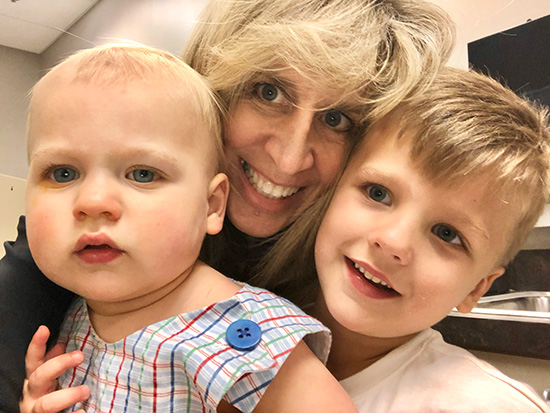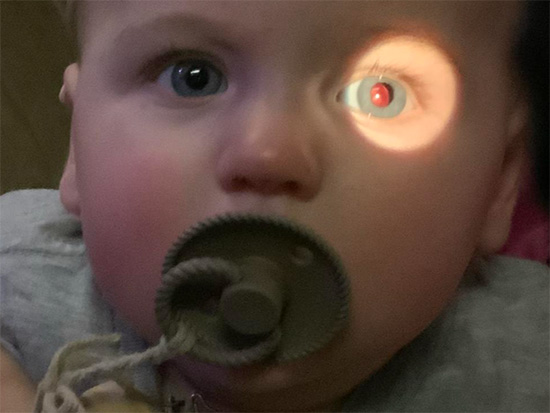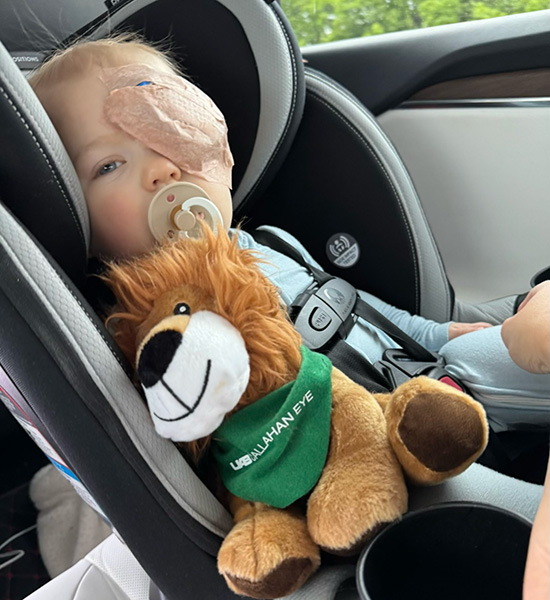Media Contact: Tehreem Khan
 Katherine Weise, OD, started treating Von and Shade Smith after their mom noticed shakiness in Von's pupil.
Katherine Weise, OD, started treating Von and Shade Smith after their mom noticed shakiness in Von's pupil.
Photo courtesy: Jamie Smith
After a long day at work, Jamie Smith expected to have a normal night at home with her two sons. But when she noticed her youngest son’s eyes shaking, she knew something was wrong.
At 4 months old, Von Smith was taken to the University of Alabama at Birmingham Eye Care for an appointment after his mother spotted some shakiness in the colored part of his eyes.
“I was looking at Von and I noticed the smallest shake in his eyes,” Jamie said. “I took a video and sent it to my friend, who showed a doctor at UAB. They recommended I bring Von in as soon as possible.”
Katherine K. Weise, O.D., professor in the Department of Optometry and Vision, along with Abigail Witmer, O.D., former resident in pediatric optometry at UAB, and their fourth-year optometry student interns, were the first to see Von. Upon their first assessment, they noticed a “wavy iris” and an abnormal pupil shape.
“I saw the subtle shake and noticed the oval pupil,” Weise said. “Babies should have perfectly round pupils. When they are oval, we want to see them. When we see a shaking or vibrating iris, there is concern that the lens behind the iris that normally keeps the iris muscle from moving too much is loose.”
Witmer says that to determine a treatment for Von they had to take several things into consideration, including trauma, genetic conditions and infections.
“The wavy iris could mean a lens dislocation has occurred, which could be due to a traumatic event, infection or an inherited syndrome,” Witmer said. “We had to go through the patient history and really investigate to find what was causing the shakiness.”
They were able to get a full medical history and found no trauma, disease or genetic disorders. Upon further examinations, Weise and Witmer found that Von has ectopia lentis.
 “Congenital ectopia lentis means that the lens that sits behind the pupil allowing you to see is dislocated,” Weise said. “This is a very rare condition with about six out of 100,000 people showing symptoms.”
“Congenital ectopia lentis means that the lens that sits behind the pupil allowing you to see is dislocated,” Weise said. “This is a very rare condition with about six out of 100,000 people showing symptoms.”
Photo courtesy: Abigail Witmer“Congenital ectopia lentis means the lens that sits behind the pupil allowing you to see is dislocated,” Weise said. “This is a very rare condition with about six out of 100,000 people showing symptoms.”
After identifying the condition, Weise and Witmer still had to find what was causing it. They conducted genetic testing. While they waited for results, they gave Von’s 4-year-old brother, Shade, a comprehensive eye exam too.
“We discovered that Shade had the very same issue, but in a milder form. We put him in a strong pair of glasses to help the vision develop normally,” Witmer said. “Since Shade also had lens dislocation, it seemed more likely to be caused by genetics rather than trauma or illness. Additionally, Shade was thriving. That suggested a good prognosis for baby brother Von.”
With discovery of lens dislocation in Von’s eyes, genetic testing was pursued with a quick cheek swab. The genetic test results revealed that Von’s condition resulted from an autosomal recessive condition, which means both parents must be carriers for it to show up in their children, even when it does not show up in the parents themselves.
Neither of the boys’ parents showed any signs or could think of anyone in the family with this rare condition. Both were surprised at this new diagnosis. The genetic issue affected only the eyes, meaning that baby Von should thrive as well as big brother Shade.
 Both boys are still being treated at UAB Callahan Eye by Rob Tauscher, MD, and Ann Marie Arciniegas, MD, and have responded well to the treatments.
Both boys are still being treated at UAB Callahan Eye by Rob Tauscher, MD, and Ann Marie Arciniegas, MD, and have responded well to the treatments.
Photo courtesy: Jamie Smith“We initially treated Von for contact lenses to help with the shakiness, and we treated Shade with glasses,” Witmer said. “However, we referred Von to the UAB Callahan Eye to help decide whether Von needed surgery to correct the subluxation.”
Both boys are still being treated at UAB Callahan Eye by Rob Tauscher, M.D., and Anne Marie Arciniegas, M.D., and have responded well to the treatments. Witmer says she is so impressed with Smith, who took initiative after noticing such a subtle shake in her child’s eyes.
“We try to always listen to the mother’s gut,” Witmer said. “And in this case, this mother’s intuition saved the vision of both of her two happy sons.”
To schedule an appointment at UAB Eye Care, click here.